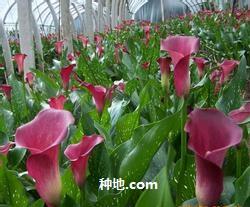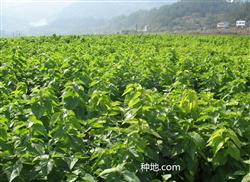How to manage colorful calla lilies?

How to manage planting colorful calla lilies? 1 present situation of color calla production color calla is a perennial bulb flower of Araceae, which is an excellent fresh cut flower and potted flower. In recent years, because of its bright color, elegant shape and wide application, colored calla lily occupies a more and more important position in the international flower market, and is recognized as the star of flowers in the century. Colorful calla lilies are native to rivers and marshes in southern Africa. It was introduced to Europe for artificial cultivation hundreds of years ago, and interspecific or intergeneric cross breeding began a hundred years ago. Colorful calla lilies are produced in many countries in the world, especially in New Zealand, the Netherlands and other countries. The time of introduction, production and application of colored calla lilies in China is not long, large-scale production is in the initial stage, but the momentum of development is good. The cultivation of white calla in Heilongjiang Province has a history of several decades, and there has been large-scale production in recent years. Heilongjiang Shuangxin Horticulture Company has basically realized the annual production of white calla fresh cut flowers. Cut flowers and seedlings have been extended to Daqing, Qiqihar, Hegang, Peony and other cities in the province, but the introduction of colored calla in the province is only in recent years, and the varieties are mainly light yellow, purple, pink and so on. 2. The ecological habit of colored calla: 2.1temperature: because colored calla grows in rivers and swamps in southern Africa, it likes to be warm and not cold-resistant. The suitable temperature for growth is about 23 ℃, the growth temperature is 18: 20 ℃, and the night temperature is above 10 ℃, but it is better not lower than 16 ℃. If the temperature is low, the flowering is delayed, and the color calla can withstand 4 ℃ low temperature. Higher than 25 ℃ or less than 5 ℃ could easily cause dormancy of colored calla lilies, and the corms would be frozen to death at 0 ℃. 2.2 Illumination: colored calla lilies prefer sunlight, especially in winter. Colored calla lilies are slightly shady, and direct sunlight in summer will cause leaf withering and sunburns. it is necessary to properly shade, 30% shading is more suitable, too much shading will affect the coloring of bracts, resulting in flowers not bright enough. The length of sunshine has little effect on flowering, and it can grow well under full or half-day sunshine. 2.3 moisture: colored calla lilies have strict requirements for water, to avoid soil drought, and too much water will cause root rot. The principle of "repeated and small amounts" should be grasped in the supply of water, and the frequency and intensity of watering should vary from season to season. Colored calla lilies have little requirement for air humidity, but excessive drying of air humidity will cause physiological diseases such as leaf curl, wilting, withered edge and hypoplastic development of spawn. It is worth noting that the air humidity should not be suddenly wet and dry. It is necessary to maintain a relatively balanced humidity environment. Acidity and alkalinity: color calla is a kind of acidic flower, and its acid-base adaptation range is pH between 5.0 and 7.5. in actual production, soil acidity is usually maintained between pH6.0~7.0 in order to control bacterial soft rot. 2.5 Nutrition: colorful calla lilies have sufficient fertilizer and fertile soil environment. Sandy loam with good permeability, slightly acidic and rich in humus is needed. 2.6 dormancy period: the dormancy of colored calla lilies varies from place to place, dormant in summer in the Cape of good Hope, South Africa, and not dormant in subtropics; potted plants are mostly planted in the temperate regions north of the Yangtze River in China, blooming indoors in winter and dormant in summer due to high temperature; when fresh cut flowers are cultivated in Heilongjiang Province, the annual production of colored calla lilies can be realized by heating in winter and cooling by shading in summer. Generally speaking, the main factor restricting the dormancy of colored calla is temperature, in addition, humidity and light will affect the growth of colored calla. Color calla lily dormancy is a passive adaptation to adverse environment, too high and too low temperature will cause calla lily dormancy. 2.7 flowering period: the flowering period of colored horseshoe is longer, but due to different varieties and different cultivation areas, the flowering period is also different. Generally, the indoor potted plants are planted in the temperate zone north of the Yangtze River, and the flowering period is mostly from the end of December to May of the following year. Among them, the flowering period is from February to March, and from December to March in the south subtropics of the Yangtze River. In areas above 1000m above sea level, the flowering period can be extended to August to October. By controlling the temperature, light and planting time of colored calla, the florescence of calla can be controlled effectively. 3 Propagation methods of colored calla the main propagation methods of colored calla are ball-dividing propagation and sowing propagation. The method of dividing balls is mostly carried out in the dormant period, and the tubers are planted and can blossom in the second year. Because of its long cycle and great variation, the method of sowing and reproduction is mainly used in the breeding of colored calla, but it is not used in production. Generally, it is sown around October and the suitable temperature for germination is about 20 ℃. With the development of modern biotechnology, large-scale rapid propagation of colored calla by tissue culture will gradually replace the traditional propagation method, because tissue culture not only has a high speed and uses stem tip culture, but also can greatly reduce the chance of virus infection and get a large number of healthy seedlings. 4 key points for the cultivation of colored calla the potted plants of colored calla are generally planted in early September. Because of their well-developed roots, flowerpots with at least high 15cm should be selected, and sandy loam with good drainage and rich in humus should be used. It is best to apply some organic fertilizer as base fertilizer. After emergence, put it in a place with strong light, and keep the basin soil moist. You can see full light in winter and shade in summer. The suitable temperature is 20-25 ℃, and it should be kept above 10 ℃ in winter. Liquid fertilizer is applied once every 2 weeks in the growing season. Be careful not to pour liquid fertilizer into the petiole so as not to cause petiole rot. Colored calla should maintain sufficient moisture during its growing period, but it should not be too wet. The environment of high temperature and high humidity will cause bacterial soft rot of colored calla. Before flowering, if there are too many leaves, some of the old leaves can be removed to facilitate the extraction of flower stems. The main fertilizer should be phosphate fertilizer at flowering stage. When the weather becomes hot and the leaves of calla lilies turn yellow gradually after late June, it is necessary to control watering to promote their dormancy. After all the leaves are withered and yellow, take out the tubers and store them in a cool and ventilated place. After classifying the tubers in autumn, big balls blossom and small balls raise seedlings. When colorful calla lilies are cultivated in Heilongjiang area, ventilation and cooling measures can be taken to make them continue to grow after flowering, achieve annual growth, and even produce flowers annually. 5 Disease and pest control of colored calla lotus 5.1 Diseases: the common diseases of colored calla lotus are soft rot, virus disease, gray mold, root rot and so on. Main prevention and cure methods: ① drying and disinfecting seed balls. ② soil disinfection. ③ strengthens cultivation management. ④ should do a good job of environmental hygiene and destroy the diseased plants and germ balls in time. ⑤ rotation is appropriate. Chemical control of ⑥. 5.2 insect pests: common pests of colored calla lilies are aphids, shell insects, red spiders and so on. The main control methods are as follows: ① increases plant density. ② enhances ventilation. The corresponding chemicals were applied to control ③. Click to get more calla lilies planting techniques click to get massive flowers and trees planting technology
- Prev

How to plant calla lilies with yellow flowers?
How to plant calla lilies with yellow flowers? What should pay attention to the yellow calla lily alias Amorphophallus, Araceae calla genus. First, an overview of the yellow calla lilies Ting Xiu elegant, golden buds, green leaves, decorated with white spots, can be described as two unique ornamental plants. At present, calla lilies are widely used in garden waterscape.
- Next

How to manage mulberry trees in spring?
How can mulberry trees be planted to achieve high yield? Mulberry is a perennial woody plant. Mulberry leaves are not only the main nutritional organs of mulberry trees, but also the main "food" of silkworms. Therefore, the leaf yield of mulberry will directly affect the healthy growth of silkworm. The high-yield cultivation techniques of mulberry leaves can be considered from the following aspects. 1...
Related
- Fuxing push coffee new agricultural production and marketing class: lack of small-scale processing plants
- Jujube rice field leisure farm deep ploughing Yilan for five years to create a space for organic food and play
- Nongyu Farm-A trial of organic papaya for brave women with advanced technology
- Four points for attention in the prevention and control of diseases and insect pests of edible fungi
- How to add nutrient solution to Edible Fungi
- Is there any good way to control edible fungus mites?
- Open Inoculation Technology of Edible Fungi
- Is there any clever way to use fertilizer for edible fungus in winter?
- What agents are used to kill the pathogens of edible fungi in the mushroom shed?
- Rapid drying of Edible Fungi

